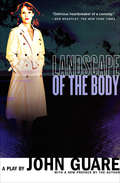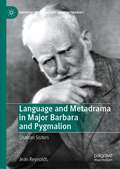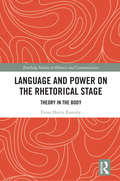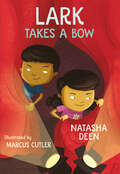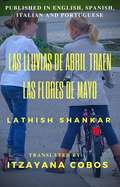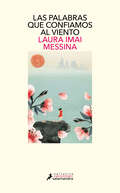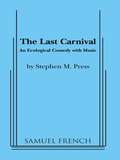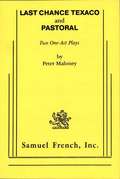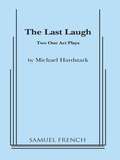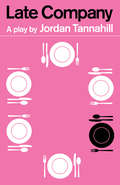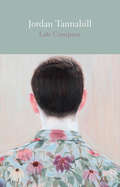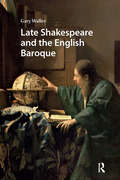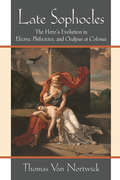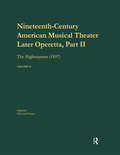- Table View
- List View
Landscape and the Arts in Early Modern Italy: Theatre, Gardens and Visual Culture (Visual and Material Culture, 1300-1700)
by Katrina GrantLandscape and the Arts in Early Modern Italy: Theatre, Gardens and Visual Culture argues that theatre, and the new genre of opera in particular, played a key role in creating a new vision of landscape during the long seventeenth century in Italy. It explores how the idea of gardens as theatres emerged at the same time as opera was developed in Italian courts around the turn of the seventeenth century. During this period landscape painting emerged as a genre and the aesthetic of designed landscapes and gardens was wholly transformed, which resulted in a reconceptualization of the relationship between humans and landscape. The importance of theatre as a key cultural expression in Italy is widely recognised, but the visual culture of theatre and its relationship to the broader artistic culture is still being untangled. This book argues that the combination of narratives playing out in natural settings (Arcadia, Parnassus, Alcina), the emotional responses elicited by sets and special effects (the apparent magical manipulation of the laws of nature), and, the way that garden theatres were used for displays of power and to enact princely virtue and social order, all contributed to this shifting idea of landscape in the seventeenth century.
Landscape of the Body: A Play (Books That Changed the World)
by John GuareDeath, desire, and tabloid sensationalism converge in “this delirious heartbreaker of a comedy” by the Tony Award-winning playwright (Ben Brantley, The New York Times).Along with Six Degrees of Separation and The House of Blue Leaves, Landscape of the Body is one of John Guare’s most celebrated plays. It tells the story of a woman’s unfulfilled life and premature death—and her reflections from the grave. Betty Yearn first came to New York City to convince her sister Rosalie to leave the gritty urban world behind and come home to bucolic Maine. But when Rosalie dies in a freak bicycle accident, Betty returns to ease into her sister’s previous persona—moving into her apartment, even taking over her job—as Rosalie watches from the beyond. Then Betty’s fortunes take a jarring turn. After losing her teenage son to murder, she finds herself the primary suspect in the crime. After all, death does seem to have a way of following in her trail. In what Michael Kuchwara of the Associated Press called “his most surreal and haunting play,” John Guare brilliantly moves back and forth in time and space to create an affecting study of the American dream gone awry.
Language & Peace (War And Peace Ser. #Vol. 6)
by Christina Schäffne Anita L. WendenFirst published in 1999. Routledge is an imprint of Taylor & Francis, an informa company.
Language and Metadrama in Major Barbara and Pygmalion: Shavian Sisters (Bernard Shaw and His Contemporaries)
by Jean ReynoldsThis book focuses on two important topics in Shaw’s Major Barbara and Pygmalion that have received little attention from critics: language and metadrama. If we look beyond the social, political, and economic issues that Shaw explored in these two plays, we discover that the stories of the two “Shavian sisters”— Barbara Undershaft and Eliza Doolittle—are deeply concerned with performance and what Jacques Derrida calls “the problem of language.” Nearly every character in Major Barbara produces, directs, or acts in at least one miniature play. In Pygmalion, Henry Higgins is Eliza’s acting coach and phonetics teacher, as well as the star of an impromptu, open-air phonetics show. The language content in these two plays is just as intriguing. Did Eliza Doolittle have to learn Standard English to become a complete human being? Should we worry about the bad grammar we hear at Barbara Undershaft’s Salvation Army shelter? Is English losing its precision and purity? Meanwhile, in the background, Shaw keeps reminding us that language and theatre are always present in our everyday lives—sometimes serving as stabilizing forces, and sometimes working to undo them.
Language and Power on the Rhetorical Stage: Theory in the Body (Routledge Studies in Rhetoric and Communication)
by Fiona Harris RamsbyThrough a fusion of narrative and analysis, Language and Power on the Rhetorical Stage examines how theater can enact critical discourse analysis and how micro-instances of iniquitous language use have been politically and historically reiterated to oppress and deny equal rights to marginalized groups of people. Drawing from Aristophanes’ rhetorical plays as a template for rhetoric in action, the author poses the stage as a rhetorical site whereby we can observe, see, and feel 20th-century rhetorical theories of the body. Using critical discourse analysis and Judith Butler’s theories of the performative body as a methodological and analytical lens, the book explores how a handful of American plays in the latter part of the 20th century—the works of Tony Kushner, Suzan Lori-Parks, and John Cameron Mitchell, among others— use rhetoric in order to perform and challenge marginalizing language about groups that are not offered center stage in public and political spheres. This innovative study initiates a conversation long overdue between scholars in rhetorical and performance studies; as such, it will be essential reading for academic researchers and graduate students in the areas of rhetorical studies, performance studies, theater studies, and critical discourse analysis.
Language in Colonization, Renaissance Poetry and Shakespeare: From Interpoetics to Translation (Literary Criticism and Cultural Theory)
by Jonathan Locke HartLanguage is the central concern of this book. Colonization, poetry and Shakespeare – and the Renaissance itself – provide the examples. I concentrate on text in context, close reading, interpretation, interpoetics and translation with particular instances and works, examining matters of interpoetics in Renaissance poetry and prose, including epic, and the Hugo translation of Shakespeare in France and trying to bring together analysis that shows how important language is in the age of European expansion and in the Renaissance. I provide close analysis of aspects of colonization, front matter (paratext) in poetry and prose, and Shakespeare that deserve more attention. The main themes and objectives of this book are an exploration of language in European colonial texts of the “New World,” paratexts or front matter, Renaissance poetry and Shakespeare through close reading, including interpoetics (liminality), translation and key words.
Languages of Trauma: History, Memory, and Media (G - Reference,information And Interdisciplinary Subjects Ser.)
by Peter Leese Jason Crouthamel Julia Barbara KöhneThis volume traces the distinct cultural languages in which individual and collective forms of trauma are expressed in diverse variations, including oral and written narratives, literature, comic strips, photography, theatre, and cinematic images. The central argument is that traumatic memories are frequently beyond the sphere of medical, legal, or state intervention. To address these different, often intertwined modes of language, the contributors provide a variety of disciplinary approaches to foster innovative debates and provoke new insights. Prevailing definitions of trauma can best be understood according to the cultural and historical conditions within which they exist. Languages of Trauma explores what this means in practice by scrutinizing varied historical moments from the First World War onwards and particular cultural contexts from across Europe, the United States, Asia, and Africa – striving to help decolonize the traditional Western-centred history of trauma, dissolving it into multifaceted transnational histories of trauma cultures.
Lark Takes a Bow (Orca Echoes #3)
by Natasha DeenMysteries seem to follow Lark and Connor Ba wherever they go, and today is no exception! The part-time detectives head to their local community theater to rehearse the play they are in, only to discover that someone is playing pranks on the theater company. The twin sleuths need to work quickly to catch the culprit before one more prank closes down the play for good. It's showtime, Lark and Connor! Lark Takes a Bow is the third title in the Lark Ba Detective series. The epub edition of this title is fully accessible.
Las lluvias de abril traen las flores de mayo
by Lathish Shankar Itzayana CobosEntradas del diario de Ashitha, una niña de 10 años escritas en jerga india. La historia nos cuenta acerca de bromas infantiles, juegos, amor, afecto y el tiempo que pasó durante las vacaciones de verano con sus amigos.
Las palabras que confiamos al viento
by Laura Imai MessinaUna novela sobre el duelo y la alegría de vivir que se ha convertido en un fenómeno internacional. Cuando Yui, una joven de treinta años, pierde a su madre y a su hija de tres años en un tsunami, empieza a medir el paso del tiempo a partir de entonces: todo gira alrededor del 11 de marzo de 2011, cuando la ola gigantesca devastó Japón y el dolor se apoderó de ella. Un día oye hablar de un hombre que tiene una cabina de teléfono abandonada en su jardín, adonde las personas acuden desde todos los rincones de Japón para hablar con quienes ya no están y hallar la paz en el duelo. Pronto, Yui emprende su propio peregrinaje hasta allí, pero al levantar el auricular no encuentra las fuerzas para pronunciar una sola palabra. Entonces conoce a Takeshi, un médico cuya hija de cuatro años ha dejado de hablar tras la muerte de su madre, y su vida da un vuelco. La crítica ha dicho:«Un impactante haiku sobre el corazón humano.»The Times «Esta novela posee una fuerza muy sutil. [...] Leerla es como un bálsamo para el alma. [...] Uno de los libros del año.»Waterstones «Un libro bellísimo y muy oportuno, que nos cuenta las consecuencias que quedan de un desastre humanitario mucho después del desastre.»Bookbag «Una lectura imprescindible, un texto precioso.»Kirkus Reviews «Con su estilo sobrio y poético, este precioso libro es una íntima historia de amor y, al tiempo, una expansiva meditación sobre la pérdida y el duelo.»Heat «Un libro para leer hoy.»Cosmopolitan (UK) «Esta historia, contada con sumo cuidado, resulta particularmente oportuna en nuestros días.»Stylist «Absolutamente impactante; te deja sin aliento.»Christy Lefteri «Laura es experta en hurgar en los bolsillos secretos de Japón. Esta vez ha encontrado un teléfono y algo de viento, y con ello ha creado una obra maestra. Es, sin duda, mi nueva escritora preferida.»Orsola Branzi (La Pina) «El espacio que separa el mundo de los vivos del de los muertos, es, a menudo, muy sutil. Y Laura Imai Messina parece conocerlo a la perfección.»Romana Petri
Lascivious Something
by Sheila CallaghanCharacters: 1 male, 3 femaleSingle Set On a secluded Greek island, an American ex-pat pursues his passions: winemaking and his breathtaking young wife. Then, on the eve of Reagan's inauguration, the first tasting of the new wine is interrupted by the unexpected arrival of August's former lover. Inspired by Greek tragedy, Lascivious Something combines evocative language with sympathetic yet deeply flawed characters straight out of Euripides. "Definitely worth spending an undeniably tense evening with, right through an unexpected twist at the end." -Associated Press "Sheila Callaghan has created a great premise and fascinating characters, her writing intertwining wine and blood and sex as painful but necessary life forces." - Back Stage "Sometimes dreamlike, often shocking, Lascivious Something is at once both fraught and languorous, its most powerful moments found in the quietest revelations or silent stares. Go with an open mind and you are certain to find that your cup runneth over with ideas by the final bow." - The Collective Magazine "Callaghan, whose previous work might be described as post-feminist punk incursions into the poetic turf of early Sam Shepard, here employs a more linear narrative line to push her personal-is-political agenda." - LA Weekly "Blown Away...Honest, captivating from beginning to end. I can't recommend it enough" -CBS News
Last Acts: The Art of Dying on the Early Modern Stage
by Maggie VinterLast Acts argues that the Elizabethan and Jacobean theater offered playwrights, actors, and audiences important opportunities to practice arts of dying. Psychoanalytic and new historicist scholars have exhaustively documented the methods that early modern dramatic texts and performances use to memorialize the dead, at times even asserting that theater itself constitutes a form of mourning. But early modern plays also engage with devotional traditions that understand death less as an occasion for suffering or grief than as an action to be performed, well or badly.Active deaths belie narratives of helplessness and loss through which mortality is too often read and instead suggest how marginalized and constrained subjects might participate in the political, social, and economic management of life. Some early modern strategies for dying resonate with descriptions of politicized biological life in the recent work of Giorgio Agamben and Roberto Esposito, or with ecclesiastical forms. Yet the art of dying is not solely a discipline imposed upon recalcitrant subjects. Since it offers suffering individuals a way to enact their deaths on their own terms, it discloses both political and dramatic action in their most minimal manifestations. Rather than mournfully marking what we cannot recover, the practice of dying reveals what we can do, even in death. By analyzing representations of dying in plays by Marlowe, Shakespeare, and Jonson, alongside devotional texts and contemporary biopolitical theory, Last Acts shows how theater reflects, enables, and contests the politicization of life and death.
Last Carnival
by Stephen M. PressEcological comedy with music / 6 or more actors to play over 15 characters / Unit set / Everything at carnival Earth is run by Carny who only cares about fun and a good show. Performers include Paul Bunyan, Buffalo Bill, John Henry, Robert Fulton and Faustus who will sell you anything-- from the Big Bomb to a cure for dandruff! Endangered species are mowed down at The Shooting Gallery and the Redwood Forests can be lost at the Wheel of Fortune. Other characters include the speedway Devil Driver, the Rotten Roll Band, Filthy Flora whose ectocyst act will surprise you, and the one who knows all-- Miriam the Mentalist. All perform and pollute the earth, but it's done with crazy comedy and famous music. Who cares about tomorrow!? Ask the kid who comes to the carnival. / "Haunting, magical, timeless and entertaining.... As you enter the strange world of this play, be prepared to be hustled, amused, shocked and enlightened."-- Taconic Newspapers.
Last Chance Texaco/Pastoral
by Peter MaloneyDrama / 3f / Interior / Originally staged to acclaim at NY's Ensemble Studio Theatre, this is a haunting, lyrical play set in a gas station run by a mother and daughter in a small Texas town. Late one night, a city woman has a flat. Her unusual life intersects with theirs as they fix her tire. This gripping piece of theatre is an excellent source of monologue and scene material. Published with Pastoral.
Last Laugh
by Michael Hardstack4m, 1f / Umbrella title for two One-Act Plays by Michael Hardstark, based on the works of Anton Chekhov - The Cure and In the Cemetery.
Last Man Standing: Mort Sahl and the Birth of Modern Comedy
by James CurtisA Times Literary Supplement 2017 Book of the YearOn December 22, 1953, Mort Sahl (1927–2021) took the stage at San Francisco's hungry i and changed comedy forever. Before him, standup was about everything but hard news and politics. In his wake, a new generation of smart comics emerged—Shelley Berman, Mike Nichols and Elaine May, Lenny Bruce, Bob Newhart, Dick Gregory, Woody Allen, and the Smothers Brothers, among others. He opened up jazz-inflected satire to a loose network of clubs, cut the first modern comedy album, and appeared on the cover of Time surrounded by caricatures of some of his frequent targets such as Dwight Eisenhower, Richard Nixon, Adlai Stevenson, and John F. Kennedy. Through the extraordinary details of Sahl's life, author James Curtis deftly illustrates why Sahl was dubbed by Steve Allen as “the only real political philosopher we have in modern comedy.”Sahl came on the scene the same year Eisenhower and Nixon entered the White House, the year Playboy first hit the nation's newsstands. Clad in an open collar and pullover sweater, he adopted the persona of a graduate student ruminating on current events. “It was like nothing I'd ever seen,” said Woody Allen, “and I've never seen anything like it after.” Sahl was billed, variously, as the Nation's Conscience, America's Only Working Philosopher, and, most tellingly, the Next President of the United States. Yet he was also a satirist so savage the editors of Time once dubbed him “Will Rogers with fangs.”Here, for the first time, is the whole story of Mort Sahl, America's iconoclastic father of modern standup comedy. Written with Sahl's full cooperation and the participation of many of his friends and contemporaries, it delves deeply into the influences that shaped him, the heady times in which he soared, and the depths to which he fell during the turbulent sixties when he took on the Warren Commission and nearly paid for it with his career.
Late Company
by Jordan TannahillOne year after the suicide of their teenage son Joel, Debora and Michael Shaun-Hastings sit down to dinner with their son’s bully and his parents. Closure is on the menu, but accusations are the main course as everyone takes a turn in the hot seat for their real or imagined part in the tragedy. Blame shifts over the course of the evening from one person to the next, and questions are raised that no one is prepared to answer.
Late Company: Second Edition
by Jordan TannahillOne year after the suicide of their teenage son Joel, Debora and Michael Shaun-Hastings sit down to dinner with their son’s bully and his parents. Closure is on the menu, but accusations are the main course as everyone takes a turn in the hot seat for their real or imagined part in the tragedy. Blame shifts over the course of the evening from one person to the next, raising questions no one is prepared to answer.
Late Shakespeare and the English Baroque
by Gary WallerLate Shakespeare and the English Baroque focuses mainly on Shakespeare’s late (or later) works, those written from around 1607. It sets both poetry and plays within the emerging culture of the baroque, the term defined not merely by stylistic features but by the underlying ideological ‘structure of feeling’ of baroque culture in early modern England. The book extends the mode of analysis of The Female Baroque (Amsterdam University Press, 2020) and draws on theoretical work by José Antonio Maravall, Raymond Williams, and Julia Kristeva. It analyzes recurring Baroque characteristics – hyperbole and melancholy, theatricality, gender, and ‘plateauing’. Attention is given to the sonnets and other poems, as well as the tragedies from Hamlet on, and argues that increasingly, tragi-comedy emerges as a distinctively baroque Shakespearean characteristic. In the final chapter, primarily on The Tempest, the late Shakespeare is shown to have philosophical insights parallel to Montaigne or Bruno, and to provide anticipatory connections with later baroque artists like Vermeer.
Late Sophocles: The Hero’s Evolution in Electra, Philoctetes, and Oedipus at Colonus
by Thomas Van NortwickOnly a few plays by Sophocles--one of the great tragic playwrights from Classical Athens--have survived, and each of them dramatizes events from the rich store of myths that framed literature and art. Sophocles' treatment evokes issues that were vividly contemporary for Athenian audiences of the Periclean age: How could the Athenians incorporate older, aristocratic ideas about human excellence into their new democratic society? Could citizens learn to be morally excellent, or were these qualities only inherited? What did it mean to be a creature who knows that he or she must die? Late Sophocles traces the evolution of the Sophoclean hero through the final three plays, Electra, Philoctetes, and Oedipus at Colonus. The book's main thesis, that Sophocles reimagined the nature of the tragic hero in his last three works, is developed inductively through readings of the plays. This balanced approach, in which a detailed argument about the plays is offered in a format accessible to nonspecialists, is unusual--perhaps unique--in contemporary Classical scholarship on Sophocles. This book will appeal to nonspecialist readers of serious literature as well as scholars of classical and other literatures. While including ample guidance for those not familiar with the plays, Late Sophocles goes beyond a generalized description of "what happens" in the plays to offer a clear, jargon-free argument for the enduring importance of Sophocles' plays. The argument's implications for longstanding interpretational issues will be of interest to specialists. All Greek is translated.
Late Sunday Afternoon, Early Sunday Evening
by Jean Lenox ToddieComedy/Drama / 2 f. / Bare stage / Lovely Olivia walks through the rooms of her Boston home with hyacinths in her arms and amethysts in her ears, remembering her past incarnations and finding this one lacking in excitement. Her granddaughter is due; she has an announcement to make!
Later Operetta 2: the Highwayman, Music by Reginald DeKoven, Libretto by Harry B. Smith, 1897 (Nineteenth-Century American Musical Theater Series)
by Reginald De KovenThe most successful American-born composer of operetta at the end of the nineteenth century was Reginald de Koven. The work reprinted in this volume, The Highwayman, is arguably his best work, although he is better known for the earlier Robin Hoodwixh its evergreen wedding ballad "Oh Promise Me." (Robin Hood is available as a reprint in the 1990 volume American Opera and Music for the Stage, in the G.K. Hall series Three Centuries of American Music.) The editor of this volume, Orly Leah Krasner, is a leading scholar of de Koven’s music. She teaches at the City University of New York, and her Ph.D. dissertation, "Reginald de Koven (1859-1920) and American Comic Opera at the Turn of the Century," is also from that university. Her introduction places the work in the tenor of contemporary critical reaction, and lists the sources available for further study. The Highwayman is one of the few complete operettas of its era for which we are fortunate enough to have original performing materials in the composer’s own hand. As the penultimate volume (number 15) in this series, de Koven’s work of 1897 contrasts with two works of the previous year, Walter Damrosch’s opera The Scarlet Letter (volume 16) and John Philip Sousa’s operetta El Capitan (volume 14).
Latin American History at the Movies
by Edited by Donald F. StevensMovies are meant to be entertaining, but they can also be educational. People are naturally curious to know how much of what they see on their screens might be historically true. In Latin American History at the Movies, experts on Latin America focus on five centuries of history as portrayed in feature films. An introduction on the visual presentation of the past in movies sets the stage for essays that explore sixteen of the best feature films on Latin America made from the 1980s to the present.
Latin American Melodrama: Passion, Pathos, and Entertainment
by Darlene J. SadlierLike their Hollywood counterparts, Latin American film and TV melodramas have always been popular and highly profitable. The first of its kind, this anthology engages in a serious study of the aesthetics and cultural implications of Latin American melodramas. Written by some of the major figures in Latin American film scholarship, the studies range across seventy years of movies and television within a transnational context, focusing specifically on the period known as the "Golden Age" of melodrama, the impact of classic melodrama on later forms, and more contemporary forms of melodrama. An introductory essay examines current critical and theoretical debates on melodrama and places the essays within the context of Latin American film and media scholarship. Contributors are Luisela Alvaray, Mariana Baltar, Catherine L. Benamou, Marvin D'Lugo, Paula Félix-Didier, Andrés Levinson, Gilberto Perez, Darlene J. Sadlier, Cid Vasconcelos, and Ismail Xavier.
Latin American Women Dramatists: Theater, Texts, and Theories
by Catherine Larson and Margarita Vargas&“This thoughtfully crafted . . . insightful and informative [anthology] elucidates an overlooked, essential component of the Latin American literary canon&” (Choice).Latin American Women Dramatists sheds much-needed light on the significant contributions made by these pioneering authors during the last half of the twentieth century. Contributors discuss fifteen works of Latin-American playwrights, delineate the artistic lives of women dramatists from countries as diverse as Argentina, Brazil, Chile, Mexico, Puerto Rico, and Venezuela. Looking at these writers and their work from political, historical, and feminist perspectives, this anthology also underscores the problems inherent in writing under repressive governments.&“The book highlights the many possibilities of the innovative work of these dramatists, and this will, it is to be hoped, help the editors to achieve one of their other key goals: productions of the plays in English.&” —Times Literary Supplement, UK

